A View from Purdue: Indiana Manufacturing
Manufacturing has traditionally been an important source of employment and income in the Indiana economy. In 1999, following a long-term trend, Indiana held the distinction of having the highest percentage in the nation of its gross state product from manufacturing (31%). Kentucky was second with 28 percent (see Figure 1).
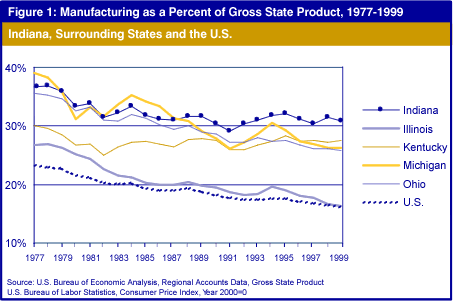
Our five largest manufacturing industries accounted for 63 percent of manufacturing gross state product in 1999. Four of these industries have shown growth since 1995. Motor vehicles and equipment showed the highest rate of growth (see Figure 2).
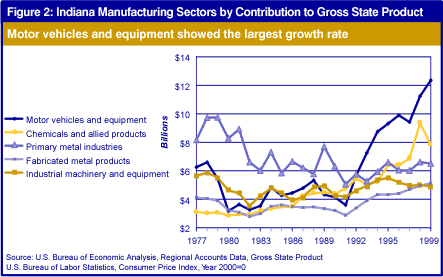
Indiana also had the largest percent in the nation of its workforce involved in manufacturing (see Figure 3). In 2000, 19 percent-697,610 of the state's 3,691,768 jobs-were in the manufacturing sector.
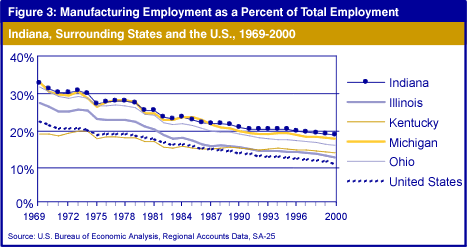
Although dominant in the state economy, manufacturing has not been Indiana's most rapidly growing sector. Indiana's services sector has followed a national trend of high growth since the 1980s. All other Indiana sectors demonstrated more moderate growth. During the 1990s, manufacturing employment was relatively stable, adding 68,276 jobs; the service and retail sectors added 352,730 jobs during the same time period (see Figure 4).
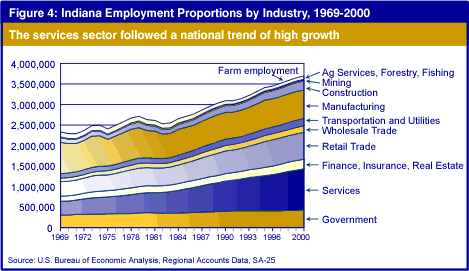
Wages and Earnings
Economic well-being can be reflected in terms of wages. While the services
sector added a substantial number of new jobs in the last two decades, it
was not among the five highest paying employment sectors of Indiana in 2000
(see Figure 5).
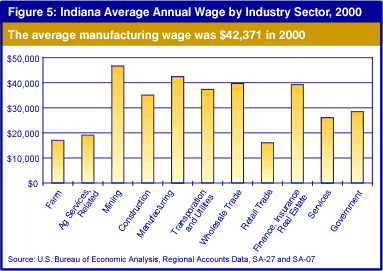
The historical importance of manufacturing can be seen in wages: the average wage in manufacturing in 2000 was $42,371, or 157 percent of the average non-manufacturing wage of $26,900 (see Figure 6).
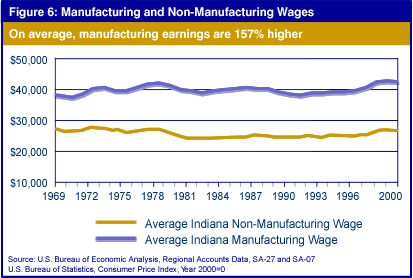
Manufacturing's higher average pay is reflected in per capita disposable income. A standard of living index based upon per capita disposable income is shown in Figure 7. On average, Indiana has maintained its share of U.S. manufacturing wages and per capita disposable income.
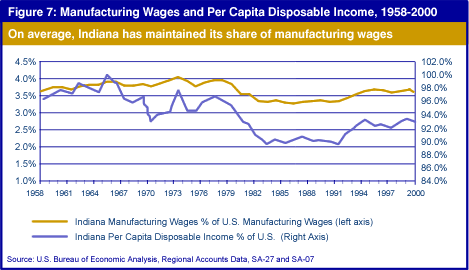
Total Indiana manufacturing wage and salary payments comprised 29 percent ($33.2 billion of $116 billion) of Indiana earnings by place of work in 2000. The highest average manufacturing pay was in the chemicals and allied products sector which includes pharmaceuticals (see Table 1). The lowest wage was in apparel and other textile products.
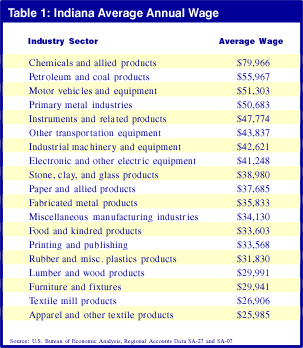
Sustaining the Sector
High wages and employment make sustaining the manufacturing sector a key
issue for the economic future of Indiana. As Indiana emerges from recession,
the manufacturing sector remains challenged by the demands of international
competition and an evolving economy. Regardless of these challenges, the Bureau
of Labor Statistics forecasts that manufacturing will maintain its dominance
on the Indiana economy through the end of the decade.
In preparing for the future, Indiana needs to find ways to build on traditional strengths in manufacturing, and stimulate high value-added activity in more industries. Recent studies by the Battelle Memorial Institute and DRI/ McGraw Hill (1) recommend encouraging the growth of "clusters" (agglomerations of related industries) and establishing policies that encourage value-added employment. The studies also suggest improvements in the quality of primary education, the business environment, vocational training, retention of high-tech graduates and interaction between higher education and industry. A stronger link to higher education's research innovations and expertise would benefit Indiana industries and, perhaps, increase career opportunities in the state.
To increase the synergy and growth of industry clusters, collaboration could be encouraged by organizing trade groups, local and cooperative purchasing arrangements, and tracking the availability of related support services such as data processing, programming and other computer support resources.
As the new economy emerges and work activities become increasingly automated, industry and elected leaders will need to decide whether Indiana should continue to be a powerhouse of manufacturing only or strive to add other high value-added endeavors. The key to success depends upon improving the quality of education, increasing the interaction between educational institutions and industry, a shift in business thinking to collaboration and co-opetition and encouraging the growth and liquidity of industrial clusters.
Footnote
- Battelle Memorial Institute: Indiana's Pillar Industries for 21st Century Midwestern Pre-Eminence (2000), a study prepared for the Central Indiana Corporate Partnership. DRI/McGraw-Hill: Blueprint for Economic Growth for Indiana (BEGIN), (1996), prepared for the Indiana Chamber of Commerce.
Kevin T. McNamara and David L. Brown
Department of Agricultural Economics, Purdue University
